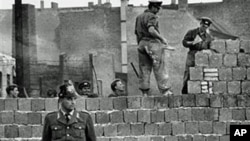On August 13, 1961, the window in the “Iron Curtain” was shut. In a single night, the border between the two parts of Berlin was closed. Thousands of people were cut off from their families, work, and homes. The Berlin Wall stood for 20,315 days. For 28 years it separated the city into two. More importantly, it divided the world.
This is a piece of the Berlin Wall, displayed at the Newseum in Washington, D.C.
For a long time the wall not only separated East Berlin from West Berlin, but also was a symbol of two worlds: the one that was free and the one behind the “Iron Curtain.”
But how did the wall appear?
Divisive split
Berlin was divided after World War II. In 1949, East Berlin - the Soviet-occupied zone - became the capital of the newly-created German Democratic Republic. West Berlin was controlled by the United States, Great Britain and France.
It was common at the time for Berliners to live in the East but work in the West, and vice versa. Every day, half-a-million people traveled freely from “socialism to capitalism” and back.
That all came to an end on August 13, 1961. In one night, the border between the two parts of Berlin was closed. The next morning thousands of people could not get around the city: the roads were closed off with barbed wire; the streets were dug up; the military was out in force. But the most striking difference was a long wall now dividing one part of Berlin from the other.
'Berlin Crisis'
Why did it happen? Because West Berlin was a “headache” for the Soviet Union and the East German regime. People and resources were leaving the communist side through the transparent border; free-market ideology was seeping through it from the West. For East Germany, it was a deeply destabilizing factor. After consulting with Moscow, the East German government decided to close off the border.
At first, people crowded on both sides of the division line. But any attempts to cross it were stopped by the East German military and police.
The West was infuriated. Tension in the city was growing. It all resulted in the so-called “Berlin crisis” - one of the most critical confrontations between the Soviet Union and the United States.
On October 28, US military jeeps, bulldozers and tanks began moving from the Western sector to the Brandenburg Gate - planning to destroy the barriers. But toward them came Soviet tanks. This was the peak of the crisis. All night the tanks stood facing one another. In the morning the machines retreated, and the immediate crisis was over. It became clear - the wall was there to stay.
Oppressive barrier
The Berlin Wall became a symbol of the Cold War. At first it was mostly barbed wire. The division line lay across squares, bridges, streets, even buildings. In 1962, a parallel wall was erected along the so-called “alienation zone.” It later became known as the “death strip” - full of trenches, booby traps and other defenses. In 1975, a new wall was built, using 45 thousand cement blocks.
The Wall stood for 20,315 days. Several hundred people died trying to cross from East Berlin to the western side. The West kept fighting for the right to free movement. Almost 50 years later, people still remember U.S. President John Kennedy’s words during a visit to Berlin in 1963: "In the world of freedom, the proudest boast is, ‘Ich bin ein Berliner’.”
And in 1987, also in Berlin, the world heard another famous speech, as President Ronald Reagan appealed to Soviet leader Mikhail Gorbachev.
Miraculous demolition
“Mr. Gorbachev, open this gate,” said Reagan.
In 1989, the wall fell, as the East German government suddenly re-opened the border.
Twenty years later, at a celebration of the 20th anniversary of the fall, U.S. Senator Ben Cardin made this observation to a VOA correspondent: “The Berlin Wall not only divided the city and the state, it divided the continent. It was a symbol of division; it was a symbol of totalitarian government of repression of human rights. People lost their lives trying to get across the wall. When it came down 20 years ago, I think it showed the future for the hope for all people in this world. To me, it’s a symbol that we should never forget.”
The idea that the world changed after the Wall fell is never disputed. The symbol of separation was annihilated by the will of the people. Freedom won.







